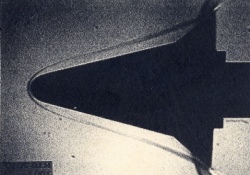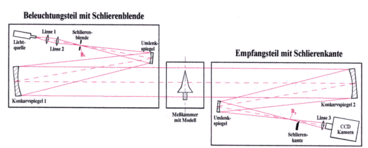schlieren measurement techniques

The beam of a light source is made parallel by a lens 1 and is than focused by a second lens 2 (Focal point B1). In this point B1 a Schlieren lens aperture is positioned, which is responsible for the cross section of the rays. The diverged beam goes from the focal point to a first mirror where the ray changes his direction and than to a concave mirror where the ray is made parallel again. Because of this the metering chamber will be x- rayed vertical to the flow direction by a widened, parallel light beam.
On the receiver side the collimated light is brought to a focus in the focal point B2 by a concave mirror. A second mirror is used again for changing the direction of the rays. A Schlieren knife edge placed at the focus B2 is positioned so that it blocks roughly half of the light. It causes a picture of the density gradient of the approaching flow. The light beams of thick air diffract stronger than of rare air. This causes bright areas (positiv density gradient) and dark areas (negativ density gradient). Finally a lens 3 takes the beam to a CCD- Camera (Charge-Coupled Device Camera).



 "
"